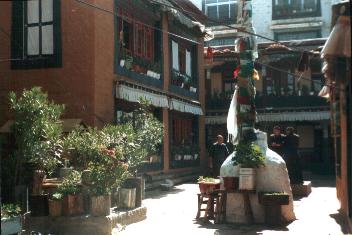| LHASA, MAY 2001 - Lhasa, the spiritual centre of Tibet… The former residence of the Dalai Lama is now a deserted museum and isolated from the old Tibetan part of town, which is the Barkhor area surrounding the heart of Tibetan budhism, the Jokhang temple. During my visit I stayed in a little (Tibetan) guesthouse, just a couple of minutes walking away from the Barkhor. I did many many times the Barkhor kora, everytime was different and other things were discovered each time. But when you wander into the little streets off from the kora, the true Tibetan experience is to be found. |
Finding your way into these side alleys is not easy – it’s more like a maze and the city map is not a great help, but you don’t get lost – just wander around and ask the people you encounter about some (to them at least) well known places.
On one of my wanderings I planned to visit the Ani Tsang Khung Nunnery. In some of the side alleys (I roughly knew which direction to go) I asked a woman who passed along about ‘Ani Gompa’. She promptly made clear to follow her and after some more streets there it was : just a yellow buiding with a gate in an ordinary street : the nunnery. As I walked in, I already attracted the attention of some nuns that were working on the roof. I just waited for a while in the center courtyard and watched what was going on. Some of the nuns were sitting on a bench and busy writing, some others were doing the laundry. I also saw pilgrims coming through the gate, going up the stairs into the temple, doing the inside kora, coming out again in the back of the temple and spinning the prayer wheels. I just continued my discovery of the courtyard, as I walked along the houses where the nuns lived. This nunnery seemed like an oasis of peace to me, and moreover everything was so clean, there were flowers and painted walls…
 |
 |
As I walked away some of the older nuns (there were a remarkable lot of younger nuns around here) tried to make clear I had to buy a ticket if I wanted to visit the temple – by buying the ticket I had the opportunity to talk to the nun that sold it to me. Surprisingly this nun, in her mid-twenties I guess, spoke English very well. She told me she was studying English outside the nunnery in a school in Lhasa. She was clearly happy to be able to talk to ‘a stranger’ – as I was the only non-Tibetan there at that time, I understood they didn’t meet foreigners a lot. I talked with her for about half an hour – and with the other nuns that were gathering around their ‘translator’. It turned out she has been in the nunnery since her birth, which is a common thing in monasteries and nunneries in Tibet. They normally do not get out, except to go on a pilgrimage. Of course (as everywhere you come in Tibet) the guidebook was a big attraction and they wanted to know all about every chapter… The nuns even gave me home-made Tibetan bread, they seemed to be pleased to have a Western visitor.

The temple
I decided after this interesting talk to visit the temple (after all I had bought this ticket). The temple itself was small and there was nothing much to see, but the amazing thing about it was that the place was full of nuns that were praying. Some of them looked up slightly… I just fell like and intruder but at the same time I could not stop looking at them and listening to their prayers – it was kind of enchanting. I also made my inside kora and left the temple again. I stopped to ask the English-speaking nun about the nuns that were praying, for how long they prayed, and at what times. She told me they were preparing for the Saga Dawa festival, and were not allowed to speak during this period and had to get up at 4 AM to pray – on some days they even didn’t have lunch. She herself and the others that were not inside the temple for the moment were to young to participate yet, they had to do the housekeeping of the nunnery while the others were praying.
I left and went back into the maze of the Tibetan streets, enriched and looking for new experiences and new encounters with the Tibetan way of life.
